Have you ever tried explaining bacteria to a child and found yourself struggling to find the right words? Explaining scientific concepts to kids can be challenging, but it’s important to teach them about the world around them, including the tiny microorganisms that can make us sick or keep us healthy. In this article, we’ll provide you with a fun and simple guide on how to explain bacteria to a child and answer some common questions they may have.
Key Takeaways:
- Teaching children about bacteria can contribute to their overall health and hygiene.
- Bacteria are tiny microorganisms that come in many different shapes and can be found everywhere, including inside our bodies.
- Bacteria can be good or bad, and it’s important to practice good hygiene to prevent the spread of harmful bacteria.
- Engaging activities and simple explanations can help children learn about bacteria in a fun and interactive way.
Why It Is Important to Teach Children About Bacteria?
As parents or educators, we want to protect and keep our children healthy. One of the best ways to achieve that is by teaching them about bacteria. Bacteria are everywhere, and some of them can cause illness. By understanding the basics of what bacteria are, how they spread, and how to fight them, children can take an active role in protecting their health and that of others around them.
- Preventing illness: When children know how bacteria can cause illness, they will be more conscious of practices that help prevent the spread of germs.
- Maintaining hygiene: Teaching children about bacteria can also help them understand the importance of hygiene practices, such as washing hands properly.
- Developing critical thinking skills: Learning about bacteria can be a great opportunity to develop critical thinking skills in children. They can learn to ask questions, research, and come to their own conclusions about what they should do to stay healthy.
Overall, teaching children about bacteria is one of the best ways to ensure they stay healthy and have a good understanding of the world around them.

What are bacteria?
Bacteria are tiny living organisms that you can’t see with your naked eye. They are so small that you would need a microscope to see them! They come in different shapes, sizes, and colors. Some bacteria are round like balls, while others are long and thin, and some are even shaped like spirals.
You might be surprised to find out that bacteria can be found almost everywhere, even on your skin and in your body! Most bacteria are harmless and don’t cause any problems, but some bacteria can make you sick and cause illnesses like the cold, flu, or food poisoning.
Image Source: 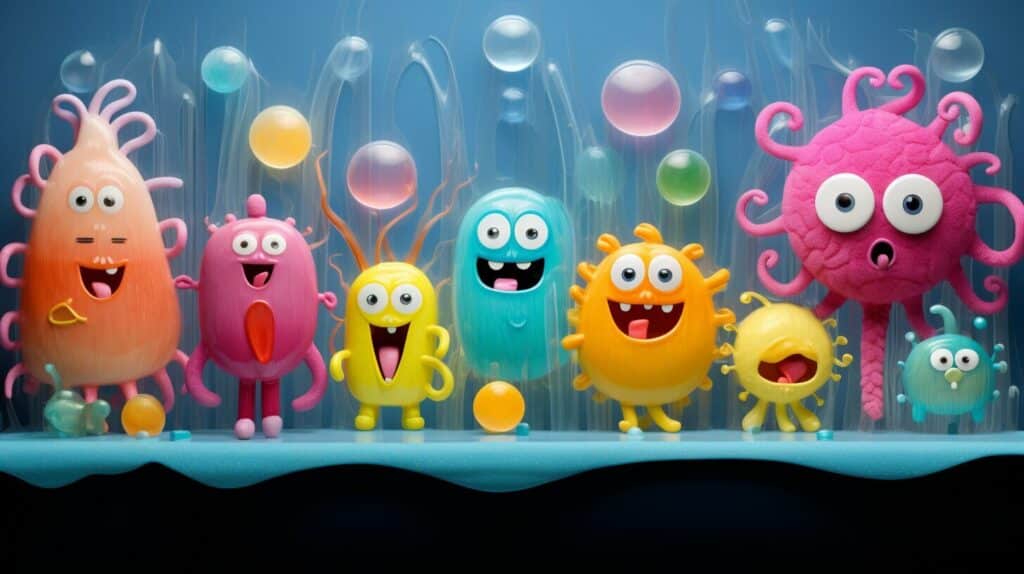
How do bacteria grow and multiply?
Now that you know what bacteria are and where they can be found, let’s explore how they grow and multiply. Bacteria can grow and reproduce very quickly, which is one of the reasons why it’s important to take steps to prevent the spread of harmful bacteria.
When conditions are right, such as having enough nutrients and moisture, bacteria begin to divide and create clones of themselves. This process is called binary fission, and it allows bacteria to quickly grow their population.
For example, if you have one bacterial cell and it divides once, you will have two bacterial cells. If those two cells each divide once, you will have four cells, and so on. This exponential growth can lead to a large number of bacteria in a short amount of time.
It’s important to note that not all bacteria grow and multiply at the same rate. Some bacteria, such as those that cause food poisoning, can double in number every 20 minutes under the right conditions. Others may take longer to reproduce.
How can you slow down bacterial growth?
While it’s difficult to completely stop bacterial growth and reproduction, there are steps you can take to slow it down. Keeping food at the right temperature, washing your hands regularly, and cleaning surfaces with disinfectants are all ways to inhibit the growth of harmful bacteria.
You can also help promote the growth of good bacteria in your body by consuming probiotic-rich foods, such as yogurt or kimchi, and avoiding unnecessary antibiotics that can kill off beneficial bacteria.
Understanding how bacteria grow and multiply can help you take proactive steps to prevent the spread of harmful bacteria. Keep these tips in mind as we continue to explore the world of bacteria.

Good bacteria vs. bad bacteria
Not all bacteria are bad! In fact, our bodies are home to trillions of good bacteria that help us digest food, fight off bad bacteria, and keep us healthy. These good bacteria are also found in some foods, such as yogurt and other fermented foods.
However, some bacteria can make us sick and cause infections or diseases. These are the bad bacteria that we need to protect ourselves from. They can be found in contaminated food, water, and even in the air we breathe.
It’s important to teach children the difference between good and bad bacteria, so they can understand the importance of good hygiene practices. Washing hands regularly with soap and water, covering your mouth when you cough or sneeze, and avoiding contact with people who are sick are all ways to protect yourself from harmful bacteria.
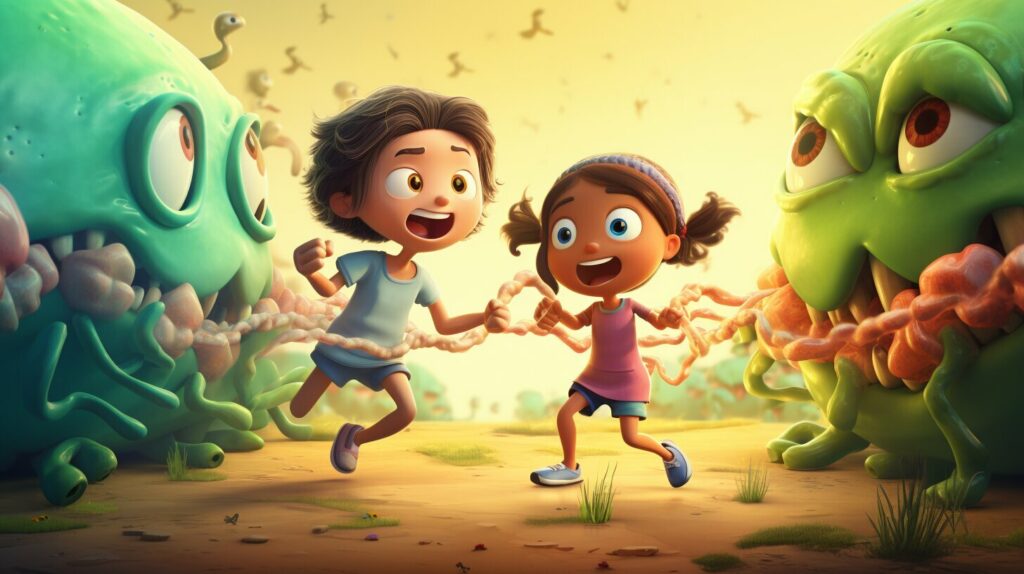
Bacteria and Illness
While some bacteria are beneficial, others can cause illness and infection. Common examples of bacterial infections include strep throat, pneumonia, and food poisoning. These illnesses can range from mild to severe, and in some cases, even life-threatening.
It’s important to understand how bacterial infections are spread and how to prevent them. Bacteria can spread through direct contact with an infected person or contaminated object, or through consuming contaminated food or water.
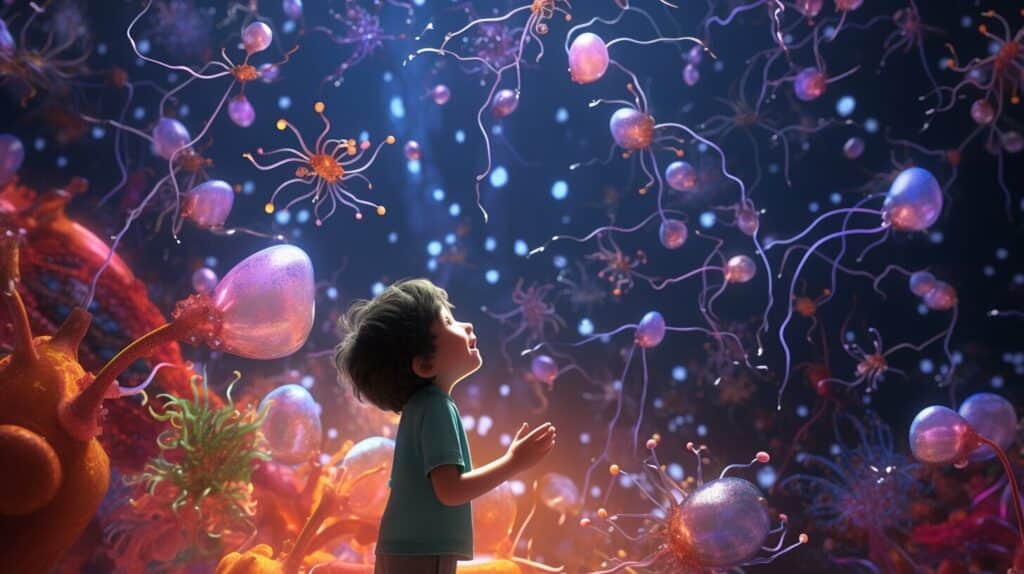
Preventing the spread of harmful bacteria involves practicing good hygiene. This includes washing your hands frequently with soap and water, covering your mouth and nose when you cough or sneeze, and avoiding sharing personal items like towels or utensils.
If you or someone you know has symptoms of a bacterial infection, it’s important to seek medical attention. Your healthcare provider can help diagnose the condition and prescribe appropriate treatment, which may include antibiotics.
How to keep bacteria in check
Now that you know what bacteria are and how they can impact your health, it’s important to take steps to keep them in check. Practicing good hygiene is key to preventing the spread of harmful bacteria.
Start by washing your hands regularly with soap and warm water. Be sure to scrub for at least 20 seconds, getting in between your fingers and under your nails. Encourage your kids to wash their hands before meals, after using the bathroom, and after playing outside.

It’s also important to keep your surroundings clean. Wipe down commonly touched surfaces, such as doorknobs and countertops, with a disinfectant. Make sure your kitchen is clean and free of food debris, as bacteria can multiply quickly in warm, moist environments.
In addition to practicing good hygiene, you can also support the growth of good bacteria in your body. Eating a healthy diet that includes probiotics, such as yogurt and kefir, can help maintain a healthy balance of bacteria in your gut. Encourage your kids to eat a variety of fruits and vegetables, as well as lean protein sources.
By taking these simple steps, you can help keep harmful bacteria at bay and support the growth of beneficial bacteria in your body.
Bacteria in Everyday Life
Bacteria are everywhere! They can be found in soil, water, air, and even on our bodies. But did you know that bacteria also play an important role in everyday life?
For starters, bacteria are used to make many of our favorite foods, such as yogurt, cheese, and pickles. They are also used to ferment beverages, such as beer and wine.
But bacteria aren’t just useful in the kitchen. They also play a crucial role in the environment by breaking down organic matter and recycling nutrients. Without bacteria, dead plants and animals would pile up and never decompose!
And inside our bodies, there are trillions of bacteria that help us digest food, boost our immune systems, and even produce vitamins.
So while some bacteria can cause illness, many are actually beneficial and necessary for life. It’s important to remember to always practice good hygiene to keep harmful bacteria at bay, but don’t forget to appreciate the positive role that bacteria play in our world!
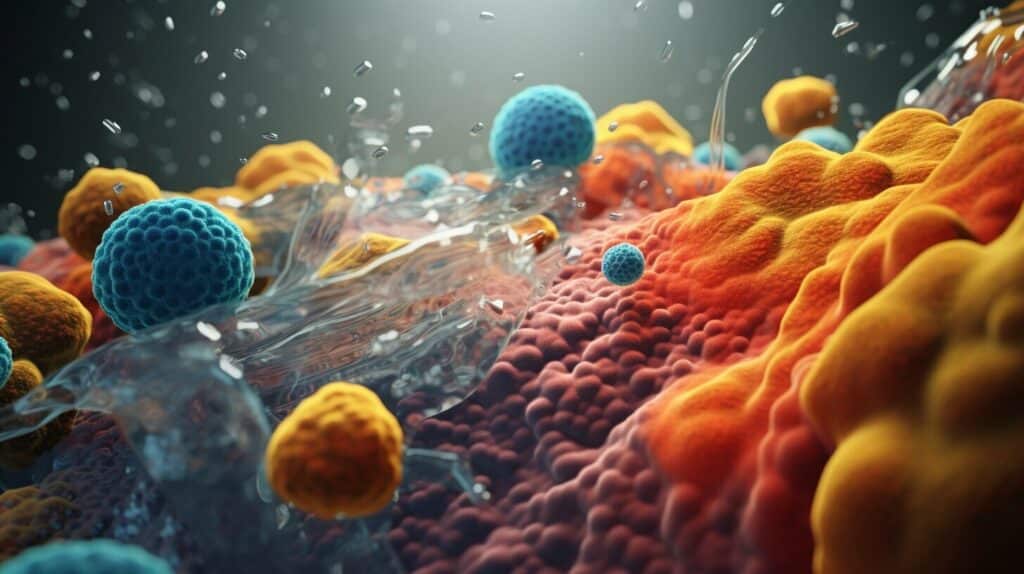
Fun activities to learn about bacteria
Teaching children about bacteria doesn’t have to be boring! In fact, there are many fun and interactive activities you can do with your kids to make learning about bacteria an enjoyable experience. Here are some ideas:
- Bacteria hunt: Take your child on a scavenger hunt around the house to find bacteria hotspots. Use a UV flashlight to highlight areas where bacteria may be lurking, such as doorknobs, remote controls, and kitchen counters.
- Growing bacteria: Help your child grow bacteria in a petri dish using household items, such as a cotton swab and agar. You can purchase ready-made kits online or create your own using instructions found on educational websites.
- Bacteria art: Encourage your child’s creativity by making bacteria-themed art projects, such as painting a picture of bacteria or making a collage using pictures of different types of bacteria.
- Bacteria bingo: Create a bingo sheet with different types of bacteria and play a game to see who can spot them first in real life or in pictures.
These activities not only make learning about bacteria fun, but they also provide hands-on opportunities for your child to understand the concepts in a more tangible way. Remember to always supervise your child during these activities and reinforce the importance of proper hygiene practices.

Answering Common Questions About Bacteria
Children are naturally curious and may have questions about bacteria after learning about them. Here are some common questions your child may ask and simple ways to answer them:
Can you see bacteria?
No, bacteria are too small to see with the naked eye. They can only be seen under a microscope.
Why do I get sick?
You can get sick if harmful bacteria enter your body. That’s why it’s important to wash your hands and keep your surroundings clean.
Are all bacteria bad?
No, there are good bacteria too! Good bacteria live inside your body and help keep you healthy. For example, they help you digest food.
How do bacteria move around?
Bacteria can move around by using tiny hair-like structures called flagella.
Can bacteria be helpful to us?
Yes, some bacteria are very helpful to us! They help us make food like yogurt and cheese, and they can also help us break down organic matter in soil.
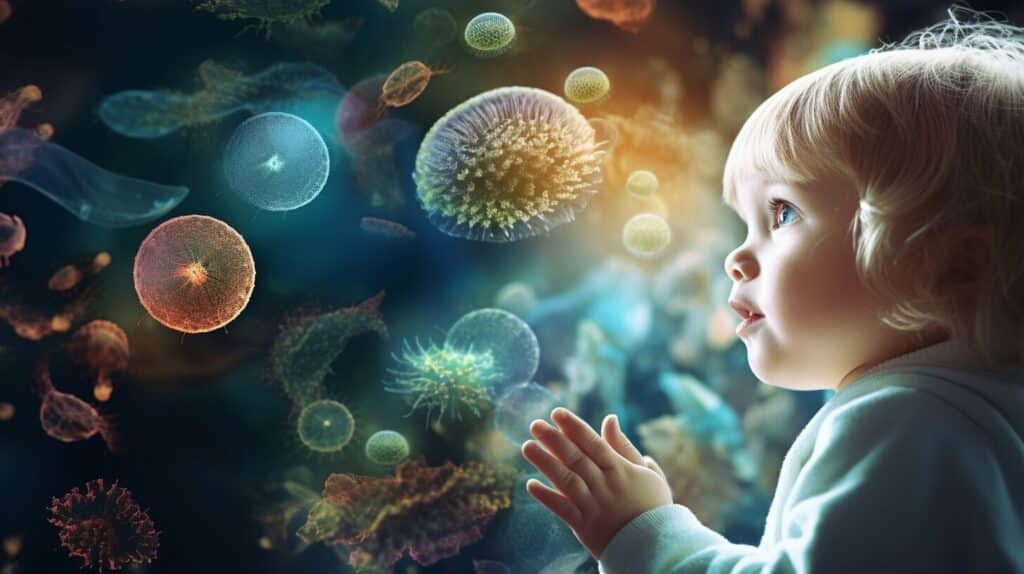
Conclusion
By answering your child’s questions about bacteria, you can help them develop a better understanding of these tiny organisms. Remember, it’s important to explain things in a way that they can understand, so use simple language and examples they can relate to.
Conclusion
Congratulations! You now have a better understanding of how to explain bacteria to a child in a fun and simple way. By teaching children about bacteria, you can help them develop good hygiene practices and promote their overall health. Remember to explain to them what bacteria are, how they grow and multiply, and the difference between good and bad bacteria. Teach them about the importance of cleanliness and how to prevent the spread of harmful bacteria. You can also make learning about bacteria fun by engaging in activities such as creating a bacteria model or going on a nature scavenger hunt to discover different types of bacteria. Don’t hesitate to answer any questions they may have, as this will encourage their curiosity and ensure that they have a thorough understanding of the topic. By following these tips and tricks, you can help your child become more knowledgeable about bacteria and develop healthy habits that will benefit them throughout their life. Good luck!Can I Use the Same Fun Guide to Explain Bacteria and Jar Sealing to a Child?
Explaining bacteria and jar sealing to a child may sound like a challenge, but with the right approach, it can be done! Using a fun guide that incorporates colorful illustrations and interactive activities, children can understand the concept of jar sealing explained to children in a simple yet engaging manner. By drawing parallels between bacteria and jar sealing process, such as the importance of cleanliness and safety, we can make these topics accessible to a young audience while keeping them entertained and informed.
FAQ
Q: Why is it important to teach children about bacteria?
A: Teaching children about bacteria is important because it helps them understand the importance of good hygiene practices and overall health. By learning about bacteria, children can develop habits that prevent the spread of harmful bacteria and reduce their risk of getting sick.
Q: What are bacteria?
A: Bacteria are tiny living organisms that can only be seen under a microscope. They come in different shapes and can be found everywhere, including on our skin, in the air, and even inside our bodies. Some bacteria are good for us, while others can make us sick.
Q: How do bacteria grow and multiply?
A: Bacteria grow and multiply by dividing into two new cells. This process is called binary fission. It’s similar to a cell splitting into two, creating two identical bacteria. This happens quickly, which is why bacteria can multiply and spread so easily.
Q: What’s the difference between good bacteria and bad bacteria?
A: Good bacteria, also known as probiotics, are beneficial to our bodies. They help with digestion, boost our immune system, and keep harmful bacteria in check. On the other hand, bad bacteria can cause illnesses and infections. Good hygiene practices, like washing hands regularly, can help prevent the spread of bad bacteria.
Q: How can bacteria cause illness?
A: Certain bacteria can cause illnesses by releasing harmful substances called toxins or by invading our body’s cells. For example, some bacteria can cause the common cold, while others can cause food poisoning. It’s important to practice good hygiene and take preventive measures to avoid getting sick.
Q: How can we keep bacteria in check?
A: There are simple ways to keep bacteria in check, such as washing hands with soap and water for at least 20 seconds, covering mouth and nose when sneezing or coughing, and avoiding sharing personal items like utensils and towels. Regularly cleaning and disinfecting surfaces, especially in the kitchen and bathroom, is also important.
Q: Where can we find bacteria in everyday life?
A: Bacteria can be found in various places in our everyday life. They can be present in food, soil, water, and even inside our bodies. Some bacteria help with processes like decomposition and nutrient recycling in nature. It’s important to understand that not all bacteria are harmful.
Q: What are some fun activities to learn about bacteria?
A: Engage children in fun activities to learn about bacteria, such as creating homemade yogurt to observe the fermentation process, using a microscope to look at bacteria samples, or conducting experiments to see the effects of handwashing on reducing bacteria. These hands-on activities make learning about bacteria exciting and interactive.
Q: What are some common questions about bacteria?
A: Some common questions children may have about bacteria include: “Can you see bacteria?” (Answer: No, they are too small to be seen without a microscope.), “Why do I get sick?” (Answer: Sometimes, harmful bacteria can enter our body and cause illness. Good hygiene helps reduce the risk.), “Where does bacteria come from?” (Answer: Bacteria can be found everywhere in our environment.), among others.






